Over 80% of Arizona is arid or semi-arid, so it may be a surprise to learn that the state is actually home to more than 4,000 native plants! Arizona is filled with various species of cacti, wildflowers, shrubs, and trees. So let’s dive right in and look at some of Arizona’s fantastic native plants!
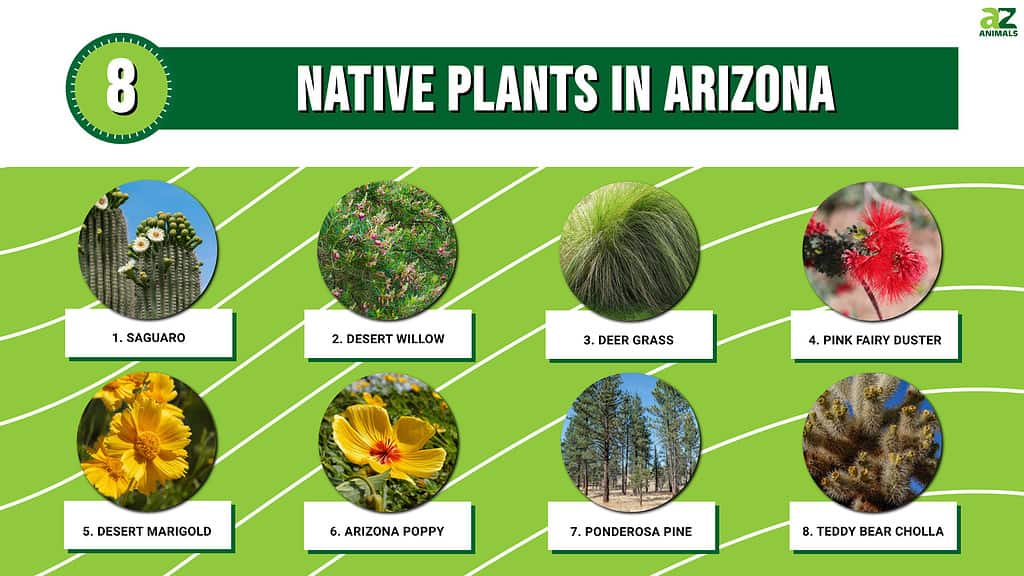
1. Saguaro (Carnegiea gigantea)
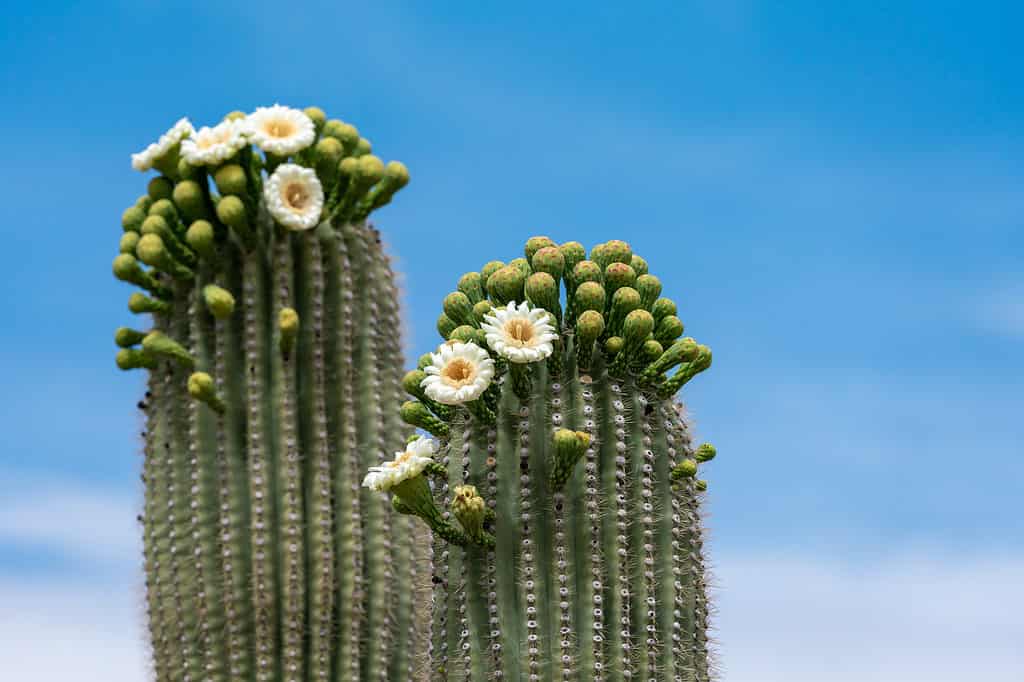
The Saguaro (
Carnegiea gigantea) is a cactus native to the Sonoran Desert in Arizona.
©JayPierstorff/Shutterstock.com
We can’t talk about native plants in Arizona without mentioning the iconic Saguaro! The Saguaro (Carnegiea gigantea) is a cactus native to the Sonoran Desert in Arizona. It is known for its distinctive shape, with a tall, columnar body and branches that extend out from the main trunk-like arms. Saguaros are a keystone species in the Sonoran Desert ecosystem.
One of the most iconic features of the Saguaro is its size. These cacti can grow to be over 40 feet tall and can weigh an incredible 4,800 pounds when fully hydrated. The size of a Saguaro is determined by the amount of water it receives. In times of drought, the cactus will shrink and wrinkle, conserving water and allowing it to survive for long periods without rainfall.
Another unique feature of the Saguaro is its life cycle. These cacti have a relatively slow growth rate and can take up to even 100 years to reach maturity. However, the Saguaro is estimated to be able to live up to 200 years old in some cases!
The Saguaro has a fascinating reproductive process, with flowers that only open at night and are pollinated by bats, bees, and even some doves. In addition, the fruit of the Saguaro is edible and has been used by Native American tribes for food and medicine.
The Saguaro is an important symbol of the American Southwest and is protected by law in Arizona. It is against the law to cut down, damage, or take down a Saguaro cactus without a permit, and violations can result in steep fines and prison time. Despite these protections, the Saguaro faces threats from climate change and urban development, and efforts are being made to conserve and protect this iconic species.
2. Desert Willow (Chilopsis linearis)
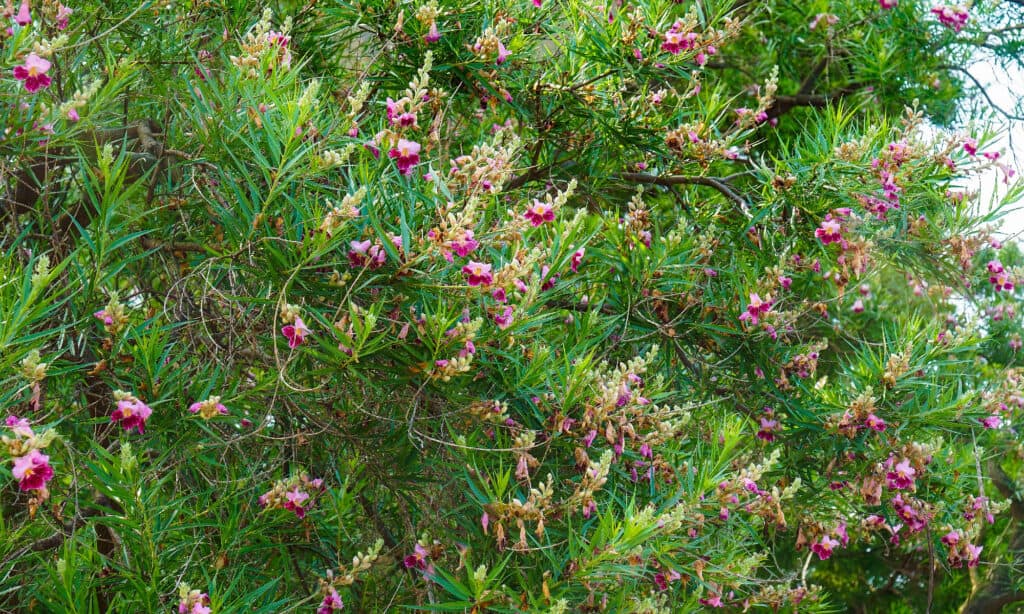
The Desert Willow is a deciduous tree, meaning it loses its leaves in the winter.
©Nikolay Kurzenko/Shutterstock.com
The Desert Willow is a beautiful flowering tree that is native to Arizona and other southwestern states. It’s called a “willow” because of its long, slender leaves, but it’s not related to the true willows. Instead, it’s a member of the Bignoniaceae family.
The Desert Willow is a deciduous tree, meaning it loses its leaves in the winter. However, in the spring and summer, it produces gorgeous trumpet-shaped flowers that come in shades of pink, purple, and white. These flowers are a favorite of hummingbirds and other pollinators, making the Desert Willow a great tree to have in your garden if you’re looking to attract wildlife.
Despite its name, the Desert Willow can actually tolerate a wide range of climates, from hot and dry to cool and moist. It can grow to be up to 30 feet tall. It’s a fast-growing tree, so it’s great for providing shade quickly. It’s also drought-tolerant, so it’s a good choice for areas where water is scarce.
Overall, the Desert Willow is a beautiful and versatile tree that is well worth considering for your garden. It’s easy to care for and gives any space a welcome burst of color and life.
3. Deer Grass (Muhlenbergia rigens)
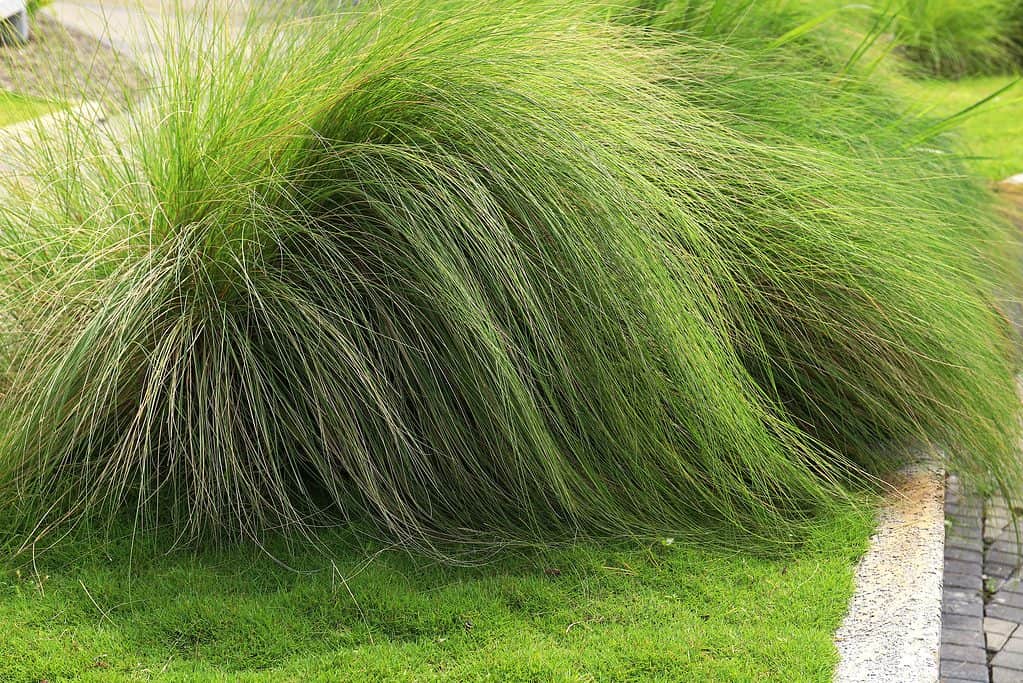
Deer grass is a tough and resilient plant that can tolerate a wide range of conditions.
©Andi WG/Shutterstock.com
Deer grass is a native perennial grass that is found across Arizona. It gets its name because it is a favorite food of deer, but it’s not just deer that enjoy it — many other animals, including rabbits and birds, also like to munch on deer grass.
One of the things that makes deer grass so appealing is its distinctive appearance. It has thin, arching leaves that are a beautiful shade of blue-green, and in the fall, it produces tall, fluffy seed heads that turn a golden-brown color. These seed heads add interest to the landscape and provide food for birds and other wildlife.
Deer grass is a tough and resilient plant that can tolerate a wide range of conditions. It’s drought-tolerant and can grow in a variety of soils, including sandy and clay. It’s also relatively low-maintenance — it doesn’t need much watering or fertilizing, and it doesn’t require regular pruning.
This beautiful grass can grow 3 to 5 feet wide and tall in optimal conditions.
In the garden, deer grass can be used as a focal point, a ground cover, or a screening plant. It’s also an excellent choice for erosion control, as its deep roots help to hold the soil in place. Overall, deer grass is a versatile and attractive plant that is well worth considering for your landscape.
4. Pink Fairy Duster (Calliandra eriophylla)
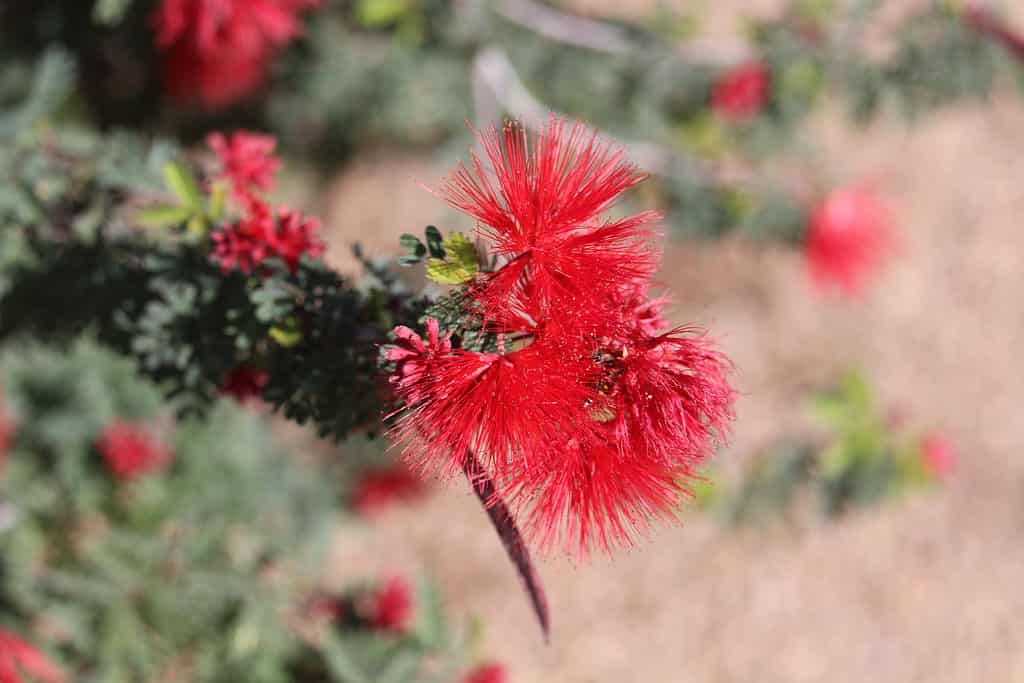
The Pink Fairy Duster has developed a unique root system with deep branching roots and fibrous clusters.
©Selina S/Shutterstock.com
The Pink Fairy Duster is a beautiful evergreen shrub native to the Sonoran Desert in Arizona and Southwestern United States. It’s aptly named, bearing dramatic magenta and pink flowers that reach up to three inches long.
This small and spiny shrub reaches up to 3 to 5 feet in height and provides a stunning display of color from late winter to early spring.
Pink Fairy Duster has adapted remarkable drought tolerance and developed a unique root system with deep branching roots and fibrous clusters. Not only that, its distinctive clouds of bright pink flowers bring even more life to the desert.
In addition, this hardy plant requires only minimal water, making it a perfect choice for dry gardens or desert landscapes. Blooms are attractive to hummingbirds and other pollinators, adding more life and beauty to the garden.
For an extra-special treat, its slender seedpods are filled with sweet nectar in late summer — irresistible to bees!
5. Desert Marigold (Baileya multiradiata)

Though they are beautiful, keep in mind that The Desert
Marigold is poisonous
.
©Barbara Ash/Shutterstock.com
The Desert Marigold (Baileya Multiradiata) is a beloved wildflower of Arizona. This plant is well-adapted to harsh conditions and is a welcome sight in the desert landscape with its beautiful, bright yellow flowers. The Desert Marigold gets its name from its resemblance to domestic garden marigolds and can be seen adorning landscapes up and down the West coast as far as Arizona and Oklahoma.
Though they are beautiful, keep in mind that these plants are poisonous. Though not specifically poisonous to humans, they may cause indigestion if eaten, so avoid eating them if possible. The Desert Marigold is particularly toxic to goats and sheep, so keep it out of pastures!
With vibrant yellow petals that can lighten any area, the Desert Marigold is relatively easy to look after with some well-drained soil and a good watering every now and then! Growing up to 1-2 feet tall in ideal conditions, the Desert Marigold is certainly an unforgettable sight that adds some undeniable charm to the summer months! It is a beautiful addition to any desert garden and an important part of the desert ecosystem.
6. Arizona Poppy (Kallstroemia grandiflora)
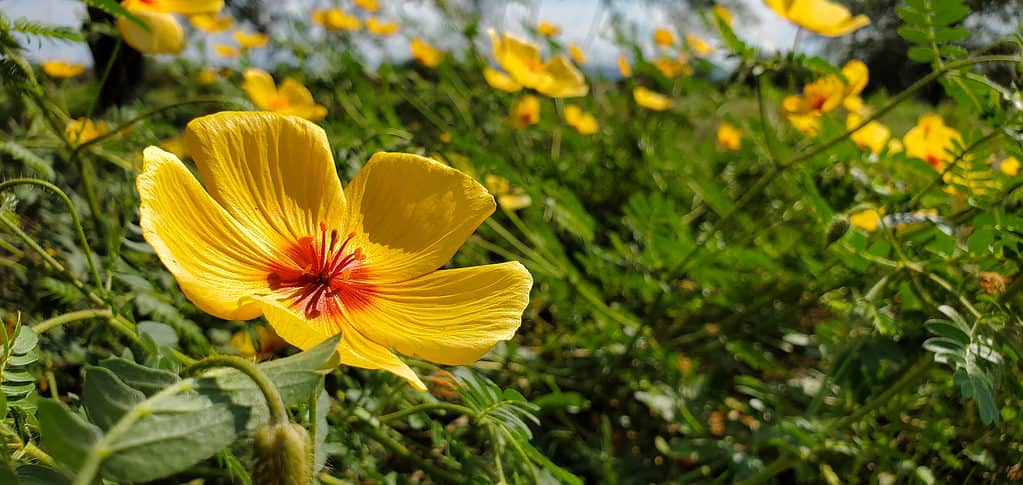
The Arizona poppy has large, showy flowers that range in color from bright yellow to orange.
©Charles T. Peden/Shutterstock.com
The Arizona poppy, also known as Kallstroemia Grandiflora, is a beautiful flowering plant native to the deserts of Arizona and northern Mexico. It is a hardy plant that can withstand extreme heat and drought, making it well-suited to the arid climate of the Southwest.
The Arizona poppy has large, showy flowers that range in color from bright yellow to orange. These flowers bloom from late spring to early summer, adding a splash of color to the otherwise barren desert landscape.
Despite its beauty, the Arizona poppy is not commonly found in cultivation and is rarely grown in gardens. This is because it is difficult to grow, requiring well-draining soil and full sun to thrive, but in ideal environments, this plant can grow up to 3 feet tall. In addition, the Arizona poppy is not a plant for small spaces as it requires large open areas where it can grow freely.
Despite these challenges, the Arizona poppy is a striking and unique plant that is well worth the effort for those willing to take on the challenge of growing it. Its bright, cheerful flowers are sure to add a touch of beauty to any desert garden.
7. Ponderosa Pine (Pinus ponderosa)
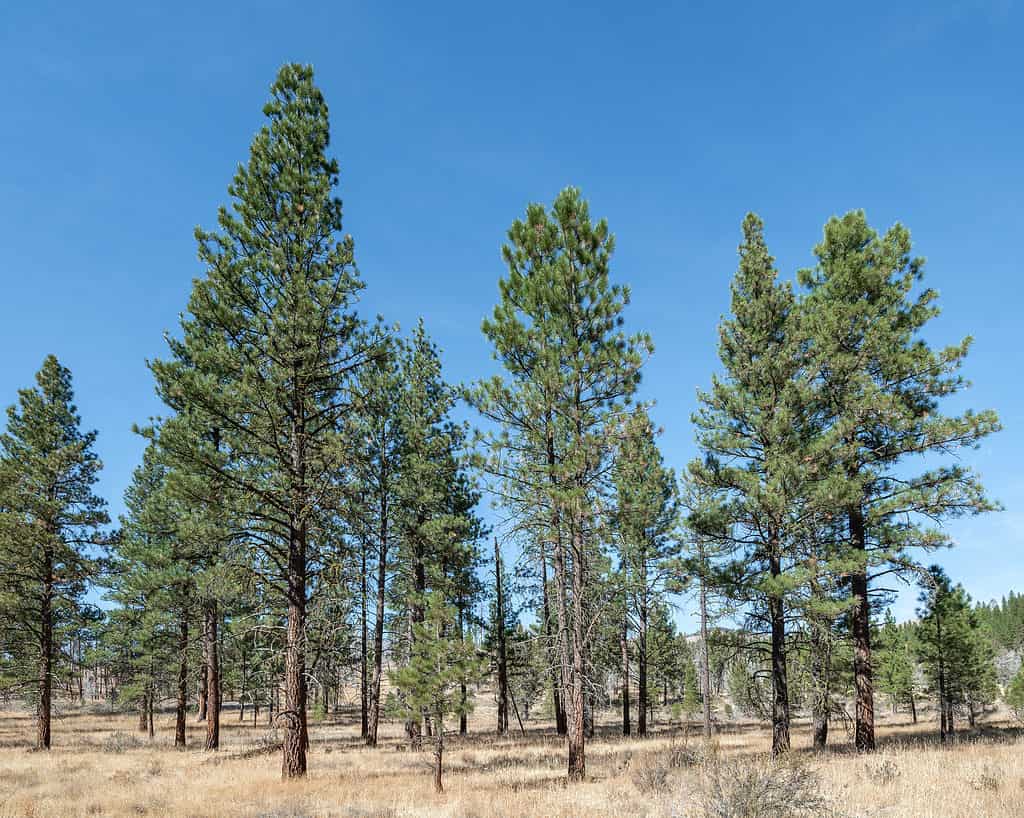
The ponderosa pine can grow to heights of more than 200 feet.
©Dominic Gentilcore PhD/Shutterstock.com
Few trees are as iconic to Arizona as the Ponderosa Pine. Loved for its strong construction yet mellow aroma, the Ponderosa has long been appreciated for lending its charm to any landscape. It is known for its ability to create a natural-looking shelter or border along any property line, and its hardiness makes it ideally suited for harsh climates.
It can thrive in many climates from dry desert-like areas to warm coastal regions. The wood of the Ponderosa Pine has so many uses. Native Americans traditionally used it to build dwellings and canoes. Nowadays, it can be used for construction materials and to make essential oils.
The Ponderosa Pine can grow up to 200 feet tall in the right environment, making it one of the tallest pine species worldwide! It is evergreen and prefers moist soil with a neutral pH, as well as plenty of sun and room to spread out. Caring for it requires frequent monitoring of pests and watering during periods of drought.
8. Teddy Bear Cholla (Cylindropuntia bigelovii)
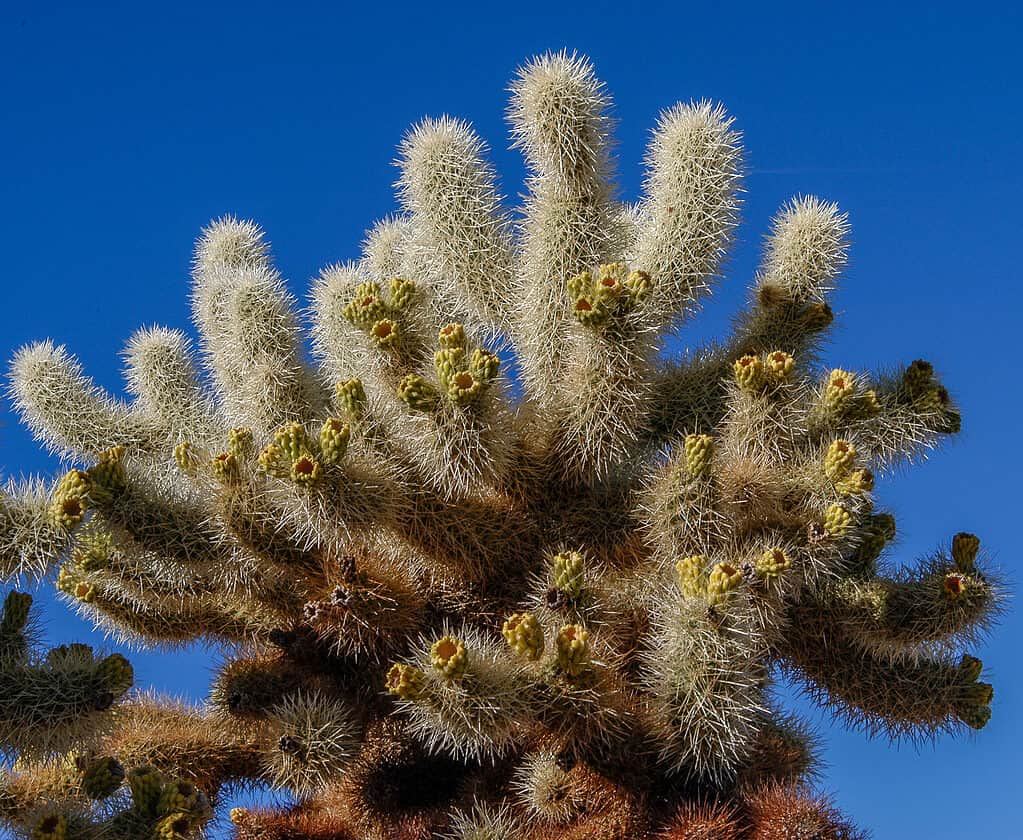
The Teddy Bear Cholla is a tough and
resilient plant that can survive in harsh desert
environments.
©Bob Coffen/Shutterstock.com
Last on our list is the Teddy Bear Cholla, also known as the Cylindropuntia Bigelovii, a type of cactus native to the desert regions of Arizona. It gets its name from its unique appearance, with soft, fuzzy-looking spines that resemble a teddy bear’s fur.
Despite its cute appearance, the Teddy Bear Cholla is a tough and resilient plant that can survive in harsh desert environments. It has thick, cylindrical stems covered in sharp spines, which help protect the plant from herbivores. The Teddy Bear Cholla can also store water in its stems, allowing it to survive long periods of drought.
The Teddy Bear Cholla is a small to medium-sized cactus that can grow up to about 3-8 feet tall. It has bright green stems that are covered in fluffy-looking spines. The plant also produces small, yellow-green flowers that bloom in the spring and summer months.
Overall, the Teddy Bear Cholla is a unique and fascinating plant well-adapted to life in the desert. Its soft, fuzzy spines may make it look cute and cuddly, but don’t be fooled — this is one tough cactus!
Summary of 8 Native Plants in Arizona
Here’s a recap of the eight plants native to Arizona that we took a look at.
| Number | Plant | Scientific Name | Range | Size |
|---|---|---|---|---|
| 1 | Saguaro | Carnegiea gigantea | Native to the Sonoran Desert in Arizona | Over 40 feet tall; weighs 4,800 pounds when fully hydrated |
| 2 | Desert Willow | Chilopsis linearis | Native to Arizona and other southwestern states | Up to 30 feet tall |
| 3 | Deer Grass | Muhlenbergia rigens | Found across Arizona | 3-5 feet wide |
| 4 | Pink Fairy Duster | Calliandra eriophylla | Native to the Sonoran Desert in Arizona and Southwestern United States | 3-5 feet tall |
| 5 | Desert Marigold | Baileya multiradiata | West Coast as far as Arizona and Oklahoma | 1-2 feet tall |
| 6 | Arizona Poppy | Kallstroemia grandiflora | Native to the deserts of Arizona and northern Mexico | Up to 3 feet tall |
| 7 | Ponderosa Pine | Pinus ponderosa | Many climates from dry desert-like areas to warm coastal regions | Up to 200 feet tall |
| 8 | Teddy Bear Cholla | Cylindropuntia bigelovii | Native to desert regions of Arizona | About 3-8 feet tall |
The photo featured at the top of this post is © Charles T. Peden/Shutterstock.com
Sources
- The Arizona Native Plant Society, Available here: https://aznps.com/the-plant-list/
- Arizona State Parks & Trails, Available here: https://azstateparks.com/desert-plants
- LawnLove, Available here: https://lawnlove.com/blog/best-native-plants-phoenix/
- Gardenia, Available here: https://www.gardenia.net/native-plants/arizona
- Backyard Garden Lover, Available here: https://www.backyardgardenlover.com/arizona-native-plants-list/
Thank you for reading! Have some feedback for us? Contact the AZ Animals editorial team.






